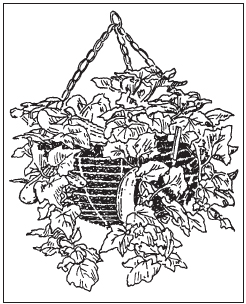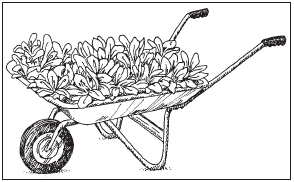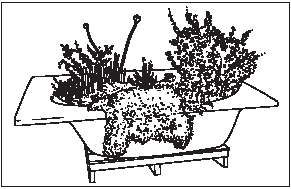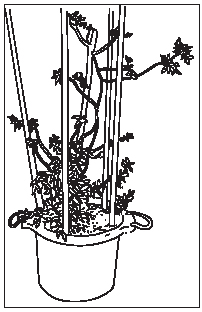
Do you want to grow veggies but live in a condominium or apartment with only limited outdoor space? Is your garden the size of a postage stamp? Is your soil hardpan or rocky? Growing your vegetables in containers is the solution to all of these problems! In this chapter you will find great advice and information on everything you need to know about growing your vegetables in containers.
The Advantages
One of the great advantages to growing vegetables in containers is they take up very little space. Containers can be placed on a balcony, porch, or patio; they can sit on a windowsill, attach to balcony railings, or hang in baskets from the rafters. They can also be used in your backyard to grow veggies that may not do well in your soil or to enhance a spot in your existing garden. Whatever option you choose, containers will provide you with some great vegetables to enjoy.
Container vegetable gardening also takes less time to maintain than a backyard garden. You'll spend much less time weeding your vegetables if you grow them in containers because the vegetable plant usually fills the pot, leaving less room for the weeds to grow.
Growing in containers can save you a sore back. Bending, lifting, digging, and twisting are all regular activities for a vegetable gardener. Gardeners with physical disabilities or back problems often find it difficult to garden. Using containers is one way to make it easier to grow vegetables. Choose containers that are the height that works for you or place smaller containers on a table or bench to make them easier to reach and enjoy.

Growing flowers among your vegetables has two advantages. They can add color and scent to your vegetable garden, which will attract beneficial insects, such as ladybugs, bees, and wasps, and repel the more harmful ones, such as aphids, slugs, and cutworms. Some great flowers to grow with vegetables are calendula, California poppies, and marigolds.
Growing vegetables in containers can add a decorative touch to your garden or patio. The containers themselves can be very attractive and the plants themselves can add color, texture, and interest to a dull or somewhat boring space. For example, Swiss chard comes in bright rainbow colors, and kale has a fabulous texture to its leaves. Peppers produce fruits that are green, red, yellow, and orange. There are many varieties of lettuce and salad greens that grow in various shades of greens and reds for you to enjoy all season long as well.
Growing your vegetables in containers allows you to be able to follow the movement of the sun. Sunlight is very important for the growth of your vegetable plants and it changes with the time of day and season. A container can be moved or turned so the plants get the amount of sunlight they need to grow well.
Heat-loving vegetables such as tomatoes and peppers are often more productive when grown in containers because the soil heats up more quickly and stays warmer. This is especially important if you live in a cool, damp climate or have unpredictable summer temperatures. These types of vegetables often need shelter from the wind and rain as well, so growing them in a container allows you the freedom to easily move them to a more sheltered area when necessary.

Growing your tomatoes in a hanging basket
Disadvantages to Container Growing
Your backyard garden often only needs watering once or twice a week because the plant roots can pull water from deep in the soil, but vegetable plants that are grown in containers do not have this option. Most containers need watering every day, but some need attention twice a day, especially during the summer months or in a hot climate. Because containers need watering so often, it is difficult to leave them unattended for any length of time.
Purchasing containers and the soil needed to fill them can also be expensive. The cost will depend on how many containers you need, and the sizes and types of containers you choose to purchase. If you are planning to grow your vegetables in a container for several years, choose a good quality one so it will last. Containers need to be cleaned on a regular basis to keep them free of pests and diseases, so choose a container that is easy to take care of.
In a garden bed you use the existing soil, but in a container you need to purchase the soil. Some or all of the soil needs to be replenished every year since the vegetable plants will use all the nutrients.

Making a shopping list before you even enter the garden center will save you time and money. Before you go, decide what vegetables you want to grow, where you will put the containers, how many containers you will need, and what sizes you need to grow your veggies.
Even though there are a few disadvantages to growing your vegetables in containers, it is definitely worth growing this way, especially if you only have a small space to grow in. Be creative and have fun making your small space beautiful!
The Best Veggies for Containers
First and foremost, grow what you love to eat. The following tips are particularly important to keep in mind if you'll be growing in containers.
Choose Dwarf Varieties
Dwarf varieties are vegetable plants that are smaller in size and therefore need less space to grow. The root system usually needs less space, which makes them a great option for containers. Go to your local garden centers and check the free seed catalogs for dwarf varieties.

Herbs are a wonderful addition to any meal! Make room for growing parsley, cilantro, and basil in your vegetable containers or garden beds. If you enjoy oregano, thyme, and sage, place these in pots of their own or in the perennial area of your garden site; these perennial herbs can be left in the same container or area for several years.
Grow Vertical
If you want to grow a lot of vegetables on your balcony or patio, employ your vertical space by using trellises or fences. Select vegetables that can be trained to grow upright. Plants grown this way will often produce even more fruit or pods for you to enjoy. Snow peas, shelling peas, pole beans, cucumbers, and tomatoes can all be grown vertically. Choose attractive materials such as bamboo, metal, or wood to make trellises or stakes for your plants to grow on.
Grow Early and Late Veggies in the Same Pot
Some vegetable plants grow better in the cool of spring or fall, while others are best planted when the weather is warmer. Vegetables will mature and be harvested at different times of the year. To make the most of your containers, plant a crop of early maturing veggies such as radishes or baby salad greens in the early spring; once you've harvested them, plant your tomatoes or peppers in that same container. This way you will have a continuous supply of wonderful vegetables to harvest and enjoy. When planning your container garden layout, make a note of which vegetables can be planted early and which will do well later in the season and make sure the size of container will work for both.
Here is a list of the most common vegetables to grow in containers:
• Beans
• Beets
• Broccoli
• Carrots
• Cucumbers
• Lettuce
• Peas
• Peppers
• Radishes
• Spinach
• Tomatoes
The Containers
Some vegetables have a shallow root system; others have much deeper roots and need more space to grow. When choosing any container for your vegetables, there are three important rules to remember: first, the container must be deep enough to hold enough soil to accommodate the plant's root growth; second, it must be large enough for the plant to grow to maturity; and finally, water must be able to drain easily from the bottom of the container so the soil does not get waterlogged. The container can be any shape so long as it can fulfill these three essentials.
Small Containers
To grow lettuce, spinach, salad greens, radishes, and green onions, a container that is approximately eight to ten inches wide and at least six inches deep will be a sufficient size. In this size container you could grow two or three of your leafy greens and up to a dozen radishes or green onions.
Clay or plastic garden pots can be easily purchased at your local garden center or hardware store. Tin cans, bricks with a center opening, milk cartons, buckets, and old cooking pots also make great containers. Garden pots usually come with holes in the bottom of them, but if you are recycling a container make sure you make at least one good drainage hole so excess water can easily drain out.

An easy way to make holes in the bottom of a lightweight container is to use a hammer and nail. Make several holes from the outside in so the holes will stay clear when you put the container upright. A drill works well for making holes in wooden or metal containers.
Medium-Sized Containers
Medium-sized containers are approximately twelve to sixteen inches wide and at least ten inches deep. You can easily grow lovely carrots, beets, peas, and beans; just remember your peas and beans will produce a better harvest if they are grown on a trellis or supported in some way. If you choose a rectangular container, you can grow your peas and beans in the back and plant your root crops in front, making great use of the space.
You can easily purchase a medium-sized container made of clay or plastic at your local garden center, but you can also reuse Styrofoam coolers, wooden crates, plastic crates (which may need a liner such as landscape fabric in order to hold the soil), or plastic ice cream buckets (ask at your local ice cream parlor for their empties). Cedar, redwood, and teak are your best choices for wood if you choose to build your own box.
Large Containers
Larger vegetables such as tomatoes, cucumbers, cabbages, broccoli, peppers, potatoes, and dwarf corn need a container more than sixteen inches wide and at least eighteen inches deep to grow well. For best results, use transplants when growing these vegetables (except for potatoes and corn). Grow only one of these plants in each container. You can grow vegetables with shallow roots such as lettuce or salad greens around the base of these plants once they are established.
There are many options for large garden pot at your garden center, but they can be expensive to purchase. Instead, reuse garbage cans, wooden barrels, metal washbasins, old wheelbarrows, or plastic clothes hampers.

Use an old wheelbarrow as a container

Bathtub Garden
When making a decision on what kind of container you want, take into account your climate and whether you will be leaving your containers outside all year long. In cold climates, the soil in your containers may freeze, which can split or break your container. If you get a lot of strong winds, lightweight containers can be blown around and damaged. If you choose not to grow anything in your containers during the off season, make sure you put them in a sheltered area such as a garage or shed so they will be protected. If you are growing your vegetables all year long, it is important that the soil does not get too waterlogged and the container is protected if you get a cold spell.

Plastic Tub Garden
Container Soil
Soil is probably the most important aspect of growing great vegetables in containers. The soil holds all the nutrients and retains all the moisture your plants need to grow. The soil needs to be rich but still lightweight enough that you can easily move your containers around. There are some excellent commercial soil mixes specifically made for container growing. Peat moss, vermiculite, and perlite make them lighter and well-rotted manures or compost keep them from drying out too quickly. These commercial mixes are sterile, which means they are free of any soil-borne diseases and they have the basic elements of nitrogen, potassium, and phosphorous.
You can make your own soil mix; just remember not to use your regular garden soil, because it is too heavy for containers and will become compacted. All container soils need to be light enough to allow good air circulation for the vegetable plants to get oxygen.
Here is a simple recipe for making your own container soil. All ingredients can easily be bought at your local garden center. Simply mix the following ingredients together:
• One cubic foot of peat moss
• One cubic foot of vermiculite
• Six ounces of lime
• Six ounces of bone meal
• One ounce of blood or alfalfa meal
• One ounce of langbeinite
One cubic foot is twelve inches in length, twelve inches in width, and twelve inches deep.
Before planting your containers, make sure the soil is well watered. The commercial soil mixes or your homemade container soil will absorb warm water more easily. When first seeding your containers, make sure they are kept in a fairly warm area but not in the direct sunlight. This will allow the seed to germinate without drying out too quickly. Seeds need to be moist in order to germinate and young transplants need more water so their shallow roots can reach the moisture. This means watering your containers often— at least once a day, sometimes twice.

If you have young children, planting fast-growing vegetables is a great way for them to enjoy and learn about vegetable gardening. Try growing radishes, lettuce, spinach, and salad greens. Have your children help you plant the seeds, water them, and watch for the new growth to push through the soil within the week.
Radishes, beets, carrots, and lettuce will need to be thinned just like when they're grown in a garden bed. A single radish or beet seed can produce several plants, so they need to be thinned to leave room for the other plants to grow to maturity. Carrot and lettuce seeds are very tiny, so it's more difficult to plant them with the proper spacing. Thinning keeps the plants from being overcrowded, and thinning will create more room for vegetables to grow and flourish.
Watering and Fertilizing
The biggest disadvantage to growing your vegetables in containers is the amount of watering they need. The size of the container, the vegetables you are growing, and the weather all determine how often and how much you need to water. When your vegetable plants are young, they need to be watered more often because the soil dries out from the top down; since your young plants do not have a deep root system yet, they need more water nearer the top of the container. As your vegetable plants mature, the roots go deeper and therefore need less frequent watering.
How Much Water?
To see whether your container needs to be watered, stick your index finger into the soil up to the knuckle. If you can feel moisture, do not water. If the soil feels dry, give the container a good drink. The container has had enough water if you can feel the moisture two to three inches from the top after you've let it sit for a few minutes. If the container is quite dry, the water will drain quickly from the bottom, leaving very little water for the soil to absorb. If this is the case, keep giving the container a drink every few minutes until the water stops draining from the bottom. Overwatering is as big of a problem as underwatering, so make sure you check your containers regularly—as much as twice a day if the pots are small and it is a hot day.
Use mulch to help keep the moisture from evaporating from your container. Mulching the top of the soil with moss, leaves, grass clippings, or even shredded newspaper can prevent the moisture from evaporating too quickly, especially in hot weather. Mulching also works well when you are growing vegetable plants that prefer a cooler soil because it will keep the soil a bit cooler as well.

Growing plants that quickly spread and invade your garden can become a problem. By growing plants such as mint and peppermint in containers you can keep them under control. You can even bury the container in your garden beds; just make sure you leave about two inches of the container rim above ground. The container prevents the roots from spreading throughout your garden.
If you are going away on vacation, especially for an extended period during the summer months, make sure you have someone water your containers while you are gone. Using a drip system on a timer is an option if you are going to be gone for a short period of time; just make sure the hoses are secured in the containers so they get watered properly. If you only have a few pots, cut off the bottom of a soda bottle or plastic milk carton, place the top of the bottle securely into the soil, and then fill the container with water. If the container is well moistened to begin with, the water will slowly be released as it is needed. This is a great option if you are gone for only a day or two. Do not use a sprinkler when watering your containers because the container may not get enough water.
Fertilizing
Moisture is important for growing your vegetables, but so are nutrients. Plants that are grown in containers have a limited supply of soil and therefore a limited supply of nutrients. To make sure your plants produce great fruit and pods, fertilize the soil. Gardeners often think that buying a good commercial soil mix will be enough to sustain the needs of their vegetable plants all season, but plants need a little boost during the season.
There are some great organic fertilizers. One option is to use a combination of liquid kelp and liquid fish fertilizer every few days. Labels will tell you how often and how much to fertilize for different sizes of containers. You can also make your own fertilizer teas (see Chapter 13).